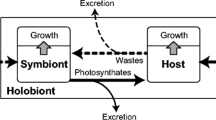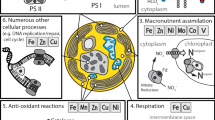Abstract.
The availability of solid food (Artemia nauplii) and dissolved inorganic nutrients (ammonium, nitrate, phosphate) to the shallow-water marine hydroid Myrionema amboinense was manipulated for 1–8 days in order to investigate their role in the growth of intracellular symbiotic dinoflagellates (zooxanthellae) of the genus Symbiodinium. Symbionts from hydroids collected from the field or maintained under laboratory conditions (25°C, 12 h:12 h light:dark cycle, 80 µE m–2 s–1 fluorescent lighting) always exhibited a single peak in mitotic index (MI) at dawn. Symbionts in freshly collected field animals had an MI peak of about 15%. Symbiotic dinoflagellates in hydroids fed Artemia nauplii twice daily in the laboratory maintained this dawn peak of MI between 10% and 15%, but in the absence of feeding or added inorganic nutrients, this peak declined to less than 1% within 2–4 days. In contrast, when hydroids were placed in solutions containing ammonium (20 µM NH4Cl), nitrate (10 µM NaNO3), and a combination of ammonium and phosphate (2 µM Na2HPO4) immediately after collection, the algal MI remained between 5% and 15% for 4–7 days; the addition of 2 µM phosphate did not increase MI relative to unfed rates. When unfed animals were placed in dissolved nitrogen or fed Artemia, the symbiont MI increased from <1% to 10–17% within 2–3 days; P alone had no effect. However, the increase resulting from added inorganic nutrients was temporary, lasting only 5–7 days. These observations suggest that algal division in the host is maintained indefinitely in the field or by feeding particulate foods twice daily in the laboratory, but the addition of inorganic nutrients alone (ammonium, nitrate and ammonium/phosphate) appeared to support the completion of a maximum of one additional round of cell division. Nutrients required for continued growth and division of symbiotic dinoflagellates are linked to host feeding and host growth; without external food, neither host nor symbiont continue to grow. The same phenomenon is seen in zooxanthellate anemones, clams and corals, where total numbers of symbionts appear to be linked to changes in host-tissue biomass (protein), achieving relatively stable densities in M. amboinense, corals and other cnidarian symbioses, depending on their local environmental conditions. The results of the present study help explain the cellular responses of algal symbionts in reef-dwelling invertebrates to additions of dissolved inorganic nutrients to coral-reef ecosystems.
Similar content being viewed by others
Author information
Authors and Affiliations
Additional information
Electronic Publication
Rights and permissions
About this article
Cite this article
Fitt, .W., Cook, .C. The effects of feeding or addition of dissolved inorganic nutrients in maintaining the symbiosis between dinoflagellates and a tropical marine cnidarian. Marine Biology 139, 507–517 (2001). https://doi.org/10.1007/s002270100598
Received:
Accepted:
Issue Date:
DOI: https://doi.org/10.1007/s002270100598




